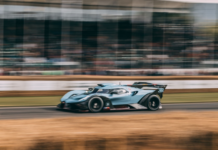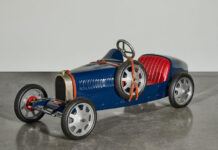“Silent streams of super-power… unbounded flexibility” “comfort to carry you to the ends of the earth” – quoted period Mercedes-Benz advertising in America for the legendary Typ S.

*A striking and beautiful example of the model
*Meticulously documented and fastidiously maintained
*Freshly refurbished paintwork by DL George Coachworks
*Well-known Classic Car Club show and tour car
The Mercedes-Benz Type ‘S’
The British Mercedes marketing would elaborate more: “Decades of experience in the building of sport cars of superior performance, the universally known high grade workmanship of the Benz-Mercedes Works and their masterly designs have contributed harmoniously to the creation of the Mercedes-Benz Sport model ‘S’, which may justly be described as the acme of motor car perfection”
Mercedes were right to make such bold statements on the arrival of their new model in the late 1920s, the equivalent motoring press would ‘wax lyrical’ about its incredible performance.
The ‘S’ was created in a magical period for the company, shortly after the merger of Daimler and Benz, while Ferdinand Porsche was Chief Engineer. He built a powerful, yet versatile automobile – a true all rounder, at home on the race track, at hill climbs and providing exhilarating driving for the road. The signature engineering feature was its ‘on demand’ Roots type supercharger, that only came into operation when the accelerator was fully depressed, boosting power output from 120 to 180 brake horsepower for a few glorious seconds!
Mercedes nestled the impressive 6.8 liter power unit into a low slung double dropped chassis, which was proudly adorned with a massive radiator. Contemporary photographs of the completely unclothed ‘S’ running gear show the model to be as beautiful, sporting and purposeful even before rakish coachwork was applied. In truly uncompromising fashion, the clearance between the engine and the hood was no more than an inch.
Mercedes debuted the cars at the opening meeting of the Nürburgring in 1927, where Caracciola set the tone with a class win, it would be the first of many laurels bestowed on the model. Here in America, Ralph de Palma drove an ‘S’ to victory in the 15 and 30-mile races at Atlantic City, averaging 80mph.
Mercedes worked hard in selling their latest definitive sports car, and despite a price tag of more than $7,000 without coachwork they found willing homes around the globe from royalty to celebrity. In America, notable owners included Al Jolson, who owned by an S and SS, the Marx brothers who famously raced their car in the Muroc Match Race, Barney Oldfield, and theater impresario Samuel Lionel “Roxy” Rathafel, of New York fame and founder of the ‘Rockettes’ dance troupe, today still present each holiday season at Radio City. While further afield enthusiasts included English Sportswoman Dorothy Paget, daughter of Pauline Payne Whitney, the Fifth Earl Howe, Sir Malcolm Campbell and novelist Sir Arthur Conan Doyle to name but a few.
Quite simply, there wasn’t anything to touch the Mercedes, but as with its competitors, it faced an uphill struggle for sales as the depression set in and only 146 of these remarkable cars were ever built between 1927 and 1930.
Mercedes’ bold claims for the model ‘S’ were endorsed universally at the time and in the 90 years that have ensued since have been held in high esteem. In Beverly Rae Kimes ‘The Star and the Laurel’, she describes the ‘S’ thus – “It was as close to a race car as could be built without actually building one.” These are sentiments which those who have had the privilege to drive an ‘S’ can only echo for their driving characteristics which are incredibly impressive. Eschewing the majestic proportions of the car, it is utterly engineered to perform at speed, with light and precise steering, stability at high digit mphs and almost unlimited power, even before the supercharger is engaged. Any comparison with its contemporaries is practically frivolous, since on face value it would seem to be from another era and is unquestionably in a class of its own.
Their qualities have been continually re-affirmed by generations of collectors, from Brooks Stevens to Bill Harrah, and examples reside in many of the most significant collections around the world, including the Simeone Foundation in Philadelphia, which houses none other than the Nürburgring winner that started it all. Some families never even parted with their cars and as recently as 2012, Bonhams sold one from the same family it had been delivered to when new. As with other coveted automobiles, from day one opportunities to purchase them rarely appear.
The Motorcar Offered
This stunning ‘S’ has spent the lion’s share of its lifetime in the present ownership, being acquired by the current owners’ father some 57 years ago in 1964. It epitomizes the presence, stance, and sheer elegance of the model and over the course of its current custody, has been at home in all aspects of the hobby, from the show field to fast road tours. The car’s provenance is supported by a fabulous treasure trove of materials charting its history and maintenance throughout this period. With letterheads from many of the luminaries in the hobby, the assemblage of documents makes for fascinating reading.
Its heritage begins in the marque’s home country, where a copy of works records denote that it was supplied through the Daimler-Benz agency of Dresden. The purchaser was Louis Delling, a successful merchant based on the Kaiserstrasse in Dresden. These papers also record that the agency took a used Minerva in part-exchange against the Mercedes, which would certainly have been quite the upgrade! Interestingly, the ‘S’ has always been known to have worn Belgian Willocq-Bottin headlamps, which might well have migrated from the Minerva. The records further note that the chassis was supplied to local coachbuilders H. Glaser & Co. on May 30, 1928.
The Mercedes had already left Germany and migrated to the United Kingdom when it was registered for the road with the London registration ‘BYM 244’ by esteemed dealers Scott Moncrieff Motors of London in 1935. This company would remain one of the best known in the industry and latterly within the hobby through to the 1980s with the legendary “Bunty” Scott Moncrieff at the helm. Their masthead proudly proclaimed they were ‘The purveyor of horseless carriages to the nobility and gentry since 1927’. This car was one of many examples of his favored marque which would pass through the business in his career.
By this time it wore a coachbuilder plate for Buhne Carosserie of Berlin, an anomaly which historians surmise is either owing to Delling having changed his mind and used a different coachbuilder when new, or that Buhne, who were a mere 120 miles north of Dresden may have carried out work on the car for Delling or its next German owner, and as coachbuilders sometimes did, took credit for their work. It is an aspect which the current owners father investigated at great length, but even a letter to Buhne themselves provided a response that they didn’t feel it was their work. It is not known to have worn any other coachwork. As a result of this when refurbished in the last decade, its owner chose to attribute the car to Glaser, and it is today badged as such.
According to a 1966 letter from the historian Michael Sedgwick and supported by the records from Ronald Johnson’s British Mercedes-Benz Club, its remaining history in the British Isles can be charted throughout. It passed to Peter Whalley of Virginia Water in Surrey in 1938 with whom it remained through the war. A period advertisement for the car at this time shows the striking Mercedes, exactly as she has always been known, painted in a dark color scheme which is believed to have been Dark Green. After this, it briefly went north to a Mr. Eadie of Glasgow in 1952, before returning south that same year to a J. Rymer of Sussex. Then on November 19, 1952 it passed to Douglas Hodson of Knapwell, Cambridgeshire. In 1953, Mr. Hodson chose to repaint the car to the more common racing color for Mercedes, white. The following year, it was offered by two prominent dealers, Performance Cars of Brentford and lastly the well-known Jack Bond, of Tooting. At some point in this small window of time, the car must have been leant to a movie studio as it makes a brief appearance in the film I am a Camera by Henry Cornelius which was released the following year. Jack Bond was responsible for selling the car to the USA in November 1954.
The current owner’s father’s correspondence reveals the three US owners prior to him and records that Harry Grey was the first owner on these shores, then Walter Stocklin of Bozman Maryland. While in his ownership, it spent some time stored in the garages of noted collector, Judge John North of Easton, Maryland, and then a restoration was begun. Stocklin did not complete the refurbishment, so when it next passed to Leo Pavelle of Purchase, New York, Mr. Pavelle sent the car to local restorers Reutters to complete the job.
The ‘S’ was placed for sale by Ed Jurist’s famed East Coast old car dealership, the Vintage Car Store, Inc. of Nyack in 1964. It was there that it was spotted by the owner’s uncle, who recommended that his brother buy it unseen. Some measure of how prized the Mercedes was can be gleaned from the fact that it cost the very significant sum of $15,000, and that a 2.9 Alfa was allowed against it for half that amount.
As soon as the owner laid eyes on the car himself it was love at first sight, and the Mercedes instantly became an integral part of family life. Copious letters were dispatched around the country, the U.K., and Europe as its history was exactingly researched, and to ensure that it was refurbished accurately.
As the owner diligently worked to make sure that a restoration was carried out accurately, he corresponded with noted experts on these cars, including Zumbach of New York and the collector M.L. ‘Bud’ Cohn in Los Angeles. Ultimately, it was supplied to George Waterman and Kirk Gibson’s Vetco New England Inc. for the aesthetic work and emerged afresh in 1968 in a distinctive two tone yellow and black scheme which it would wear for the next 50 years.
The ‘S’ was everything for the family, the children recall their father using it for everyday transport and being driven to school in it, yet on many occasions at the highest-level car shows and concours of the 1970s and 1980s, it would also be on display and frequently a prize winner.
In the last 20 years, its maintenance was entrusted to the modern masters including D L George Coachworks and Leydon Restorations. Its gigantic supercharged 6.8 liter engine was rebuilt last in the early 2000s and then properly maintained since. Not just for show, the Mercedes also routinely competed in road rallies and was last seen on the Colorado Grand in 2015, testament to its versatility and timeless performance.
On their father’s passing in 2016 the car was handed down a generation and has continued to be looked after by the late David and ‘Deeg’ George. In new care, a decision was made to repaint the car to a single hue. The stunning results of this can be seen today, the raven black suits the Mercedes perfectly and is simply accented by its copper brake drums and chrome accessories.
After some 57 years of care, the family have now decided to part with the car, and in doing so, presents a wonderful opportunity for its next custodian. As anyone who has ever driven these six-cylinder supercharged cars would attest, they are truly the special automobiles, and a decade or more ahead of their peers. It is further imbued with the most well rounded traits: Fast, safe and oozing quality in every aspect of their build. Unseen publicly in its new guise, the car would most certainly be welcomed to show fields around the country as events open up this and next year.
If you are interested in more auctions click here.




















